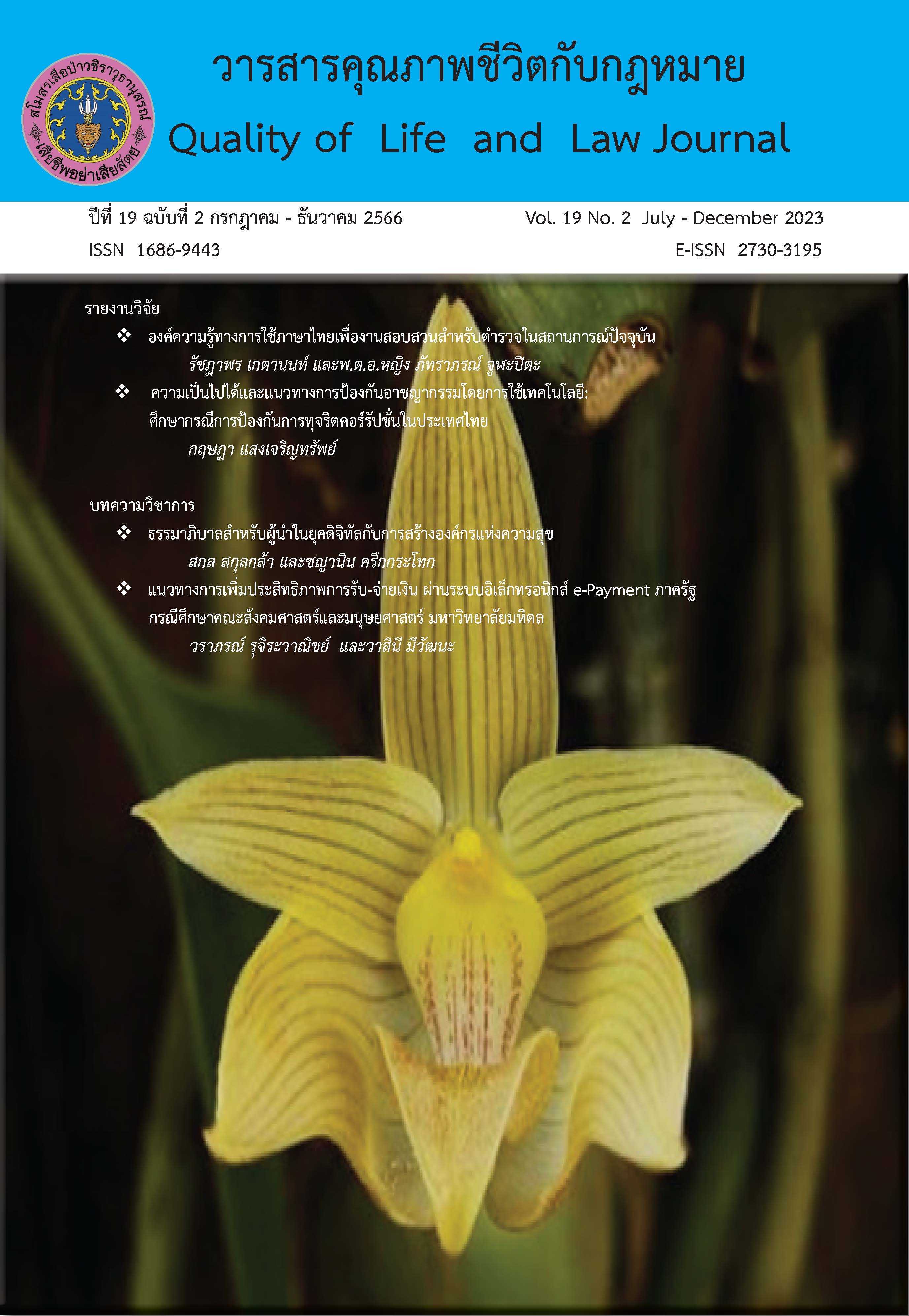Possibilities and guidelines for crime prevention using technology: A case study of corruption prevention in Thailand
Main Article Content
Abstract
The qualitative research, there was the objective of this study is to study the possibilities, problems, and obstacles of using technology to prevent corruption in Thailand. As well as suggesting guidelines appropriate to the Thai context in cases where technology will be used to solve corruption problems. The important tools used to collect data by collecting document data contain academic articles, research, laws, and Supreme Court judgments. and in-depth interviews with 22 informants.
The results of the study found that Thailand has a high tendency to use technology to prevent and solve corruption problems that occur, which can be divided into two levels: using technology at the general public level and the national level. In addition, important problems and obstacles were found, including 1) the lack of up-to-date laws, especially changes in technology; 2) work that is not yet integrated among agencies in the area of preventing or suppressing corruption; and 3) the lack of knowledge, understanding, and negative attitude of the officials involved.
The guidelines that are appropriate for Thailand in using technology to solve corruption problems include: 1) creating participation for the public sector in investigating corruption. 2) Providing knowledge about technology to officials as well as the public as appropriate. 3) Design the technology system that will be used to detect corruption so that it is difficult to alter or be hacked, and 4) Have appropriate guidelines and transparency in supervising and maintaining the technology system that will be used to prevent corruption in the future.
Article Details

This work is licensed under a Creative Commons Attribution-NonCommercial-NoDerivatives 4.0 International License.
- บทความหรือข้อคิดเห็นใดๆ ในวารสารคุณภาพชีวิตกับกฎหมายเป็
- กองบรรณาธิการไม่สงวนสิทธิ์
References
กิติพัฒน์ นนทปัทมะดุล. (2558). การศึกษาระบบอุปถัมภ์กับปัญหาสังคมไทย: การประยุกต์ใช้ของนักสังคม สงเคราะห์วิชาชีพ. วารสารสังคมสงเคราะห์ศาสตร์, 23(1), 177-197.
กรมทรัพย์สินทางปัญญา. (ม.ป.ป.). บทวิเคราะห์แนวโน้มเทคโนโลยีบล็อกเชนเพื่ออุตสาหกรรมแห่งอนาคต: Blockchain reinvent service delivery. https://ipthailand.go.th/images/2284/ BlockchainAnalysis2019.pdf
ณัฐปภัสร์ ดาราพงษ์. (2563). ปัจจัยที่มีผลต่อความน่าเชื่อถือในการทำธุรกรรมการเงินทางออนไลน์ผ่านธนาคารทางอินเตอร์เน็ตของผู้สูงอายุในเขตกรุงเทพมหานคร. วารสารนวัตกรรมธุรกิจ การจัดการ และสังคมศาสตร์, 1(1), 60-94.
ประไพพิมพ์ สุธีวสินนนท์ และ ประสพชัย พสุนนท์. (2559). กลยุทธ์การเลือกตัวอย่างสำหรับการวิจัยเชิงคุณภาพ. วารสารปาริชาติ มหาวิทยาลัยทักษิณ. 29(2), 31-48.
ปาณมน จันทบุตร, ศิริรัตน์ เจนศิริศักดิ์, และ อรุณรัตน์ เศวตธรรม. (2564). เทคโนโลยีบล็อกเชน: แนวคิดและผลกระทบสำหรับการบัญชี การตรวจสอบบัญชี และการจัดการห่วงโซ่อุปทาน. วารสารวิชาชีพบัญชี, 17(56), 75-93.
สมบัติ นามบุรี. (2562). ทฤษฎีการมีส่วนร่วมในงานรัฐประศาสนศาสตร์. วารสารวิจัยวิชาการ, 2(1), 183-197.
สำนักงานคณะกรรมการป้องกันและปราบปรามการทุจริตแห่งขาติ. (2566). สถานการณ์การทุจริตประเทศไทย ประจำปีงบประมาณ พ.ศ. 2565. https://www.nacc.go.th/files/article/attachments/ 2711726a1ab2bcb9dba3f3fd686c36e72ab78aa.pdf
Chene, M. (2011, April 12). Use of mobile phones to detect and deter corruption. U4 Anti-corruption Resource Centre. Retrieved January 17, 2021, from https:// www.u4.no/ publications/use-of-mobile-phones-to-detect-and-deter-corruption.
Girla, L. & Rub, J. (2015). White-collar crime: Definitional issues and classification. Revista Nationala De Drept, 8, 19-26.
Gottschalk, P. & Gunnesdal, L. (2018). White-collar crime in the shadow economy: Lack of detection, investigation and conviction compared to social security fraud. Springer.
Kossow, N. & Dykes, V. (2018). Embracing digitalization: How to use ICT to strengthen anti-corruption. Deutsche Gesellschaft für Internationale Zusammenarbeit (GIZ).
Kukutschka, R. M. B. (2016, November 28). Technology against corruption: The potential of online corruption reporting apps and other platforms. U4 Anti-corruption Resource Centre. Retrieved January 4, 2021, from https://www.u4.no/publications/technology-against-corruption-the-potential-of-online-corruption-reporting-apps-and-other-platforms
Transparency International. (2021). Corruption Perceptions Index (CPI) 2021. https://www.transparency.org/cpi.
We are social. (2021). Digital 2021: Global overview report. https://wearesocial-cn.s3.cn-north-1.amazonaws.com.cn/common/digital2021/digital-2021-global.pdf


